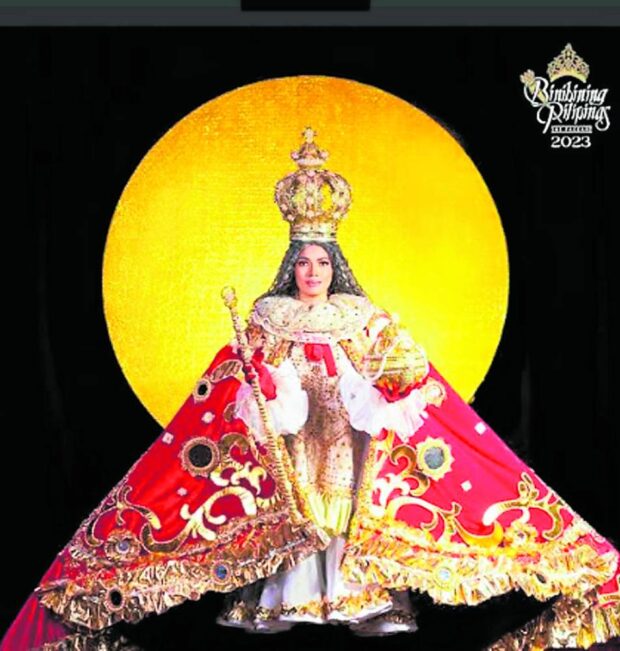Beauty contestant’s ‘Sto. Niño’ costume earns no amen

‘VIVA PIT… SENYORA?!’ The Binibining Pilipinas 2023 candidate from Cebu province had very personal and spiritual reasons for dressing up like this at the pageant. But beauty contest fashion and devotion don’t always mix. (Photo courtesy of Binibining Pilipinas)
CEBU CITY, Cebu, Philippines — She lost her father to an accident last year.
Joy Dacoron, 27, a native of Balamban town in the western part of Cebu, initially questioned God about her painful loss, but eventually accepted it after some deep reflection.
Her source of inspiration and strength: the Sto. Niño de Cebu.
And so Dacoron did not have second thoughts about dressing up like the Child Jesus in the national costume competition at the recent Binibining Pilipinas 2023 pageant, where she competed as Cebu’s representative.
‘Guided’ creativity
But the photos of the contestant in a red ornate cape, crowned and holding a golden scepter and orb, drew mostly negative reactions when posted on her Facebook and Instragram account and on the pageant’s social media channels. The images have been taken down from the Binibining Pilipinas accounts when the Inquirer checked on Wednesday.
The most serious objections were, not surprisingly, from the Catholic Church.
Fe Mantuhac-Barino, chair of the Archdiocese of Cebu’s commission on the laity, said “creativity should be guided by the Holy Spirit so the true beauty of God’s creation will come out.”
“It is important to respect culture and religion,” Barino said.
According to Cebu Auxiliary Bishop Ruben Labajo, Dacoron sought his permission to do a photoshoot for her pageant bid, with the different churches in the diocese as background.
“I have no idea that they will promote the vestments of the Holy Child as national costume,” the prelate said in a statement on Wednesday.
Friars weigh in
Without naming Decoron or directly commenting on her outfit of choice, the Augustinian friars of the Basilica Minore del Sto. Niño de Cebu also issued a statement saying: “The wearing of the Sto. Niño vestment to children is one of the expressions of faith by parents in order to help them understand and grow their faith in the Child Jesus.’’
“Children are the direct manifestations of the Holy Child—special blessings that hold the family together. For parents as the first teachers of faith, it is part of their duty to let their children be closer to Jesus,” they added.
It is important, they said, to keep in mind the “appropriateness of our actions” amid the many expressions of faith and devotion to the Child Jesus. “As Cebuano Catholics, the Sto. Niño has a profound religious and cultural importance to us. Let us approach and treat the Sto. Niño with reverence and respect in order to avoid conflict and misunderstanding.” The Augustinians friars have been serving as caretakers of the five-centuries-old image of the Sto. Niño de Cebu—the oldest sacred icon in the country which was given as baptismal gift by Portuguese explorer Ferdinand Magellan to Cebu’s Queen Juana in 1521.
In her social media post, Dacoron, a former member of the Adamson Falcons volleyball team, explained that she chose the Sto. Niño costume as a symbol of her unwavering Christian faith.
‘Ngano man, Lord?’
“When I lost my father to an accident last year, I questioned God: “Ngano man, Lord? (Why Lord?),” Dacoron said. “The Sto. Niño paved the way for me to shed off my doubts and made me realize that everything happens for a reason. In gratitude, I am sharing this faith on the national stage.”
“Thus, with pride and deep respect for our heritage, I wear this costume that signifies faith and gratefulness. Viva Pit Senyor!”